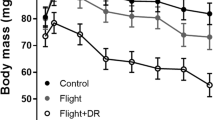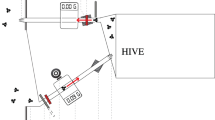Abstract
Honeybees, Apis mellifera, who show temporal polyethism, begin their adult life performing tasks inside the hive (hive bees) and then switch to foraging when they are about 2–3 weeks old (foragers). Usually hive tasks require little or no flying, whereas foraging involves flying for several hours a day and carrying heavy loads of nectar and pollen. Flight muscles are particularly plastic organs that can respond to use and disuse, and accordingly it would be expected that adjustments in flight muscle metabolism occur throughout a bee’s life. We thus investigated changes in lifetime flight metabolic rate and flight muscle biochemistry of differently aged hive bees and of foragers with varying foraging experience. Rapid increases in flight metabolic rates early in life coincided with a switch in troponin T isoforms and increases in flight muscle maximal activities (V max) of the enzymes citrate synthase, cytochrome c oxidase, hexokinase, phosphofructokinase, and pyruvate kinase. However, further increases in flight metabolic rate in experienced foragers occurred without additional changes in the in vitro V max of these flight muscle metabolic enzymes. Estimates of in vivo flux (v) compared to maximum flux of each enzyme in vitro (fractional velocity, v/V max) suggest that most enzymes operate at a higher fraction of V max in mature foragers compared to young hive bees. Our results indicate that honeybees develop most of their flight muscle metabolic machinery early in life. Any further increases in flight metabolism with age or foraging experience are most likely achieved by operating metabolic enzymes closer to their maximal flux capacity.





Similar content being viewed by others
Abbreviations
- CS:
-
Citrate synthase
- COx:
-
Cytochrome c oxidase
- HK:
-
Hexokinase
- PFK:
-
Phosphofructokinase
- PK:
-
Pyruvate kinase
- V max :
-
Enzyme maximum activity
- v :
-
In vivo pathway flux
- v/V max :
-
Enzyme fractional velocity
- \( V_{{{\text{CO}}_{ 2} }} \) :
-
Rate of carbon dioxide production
References
Allen MD (1959) Respiration rates of worker honeybees of different ages and at different temperatures. J Exp Biol 36:92–101
Benzi G, Curti D, Pastoris O, Marzatico F, Villa RF, Dagani F (1991) Sequential damage in mitochondrial complexes by peroxidative stress. Neurochem Res 16:1295–1302
Blatt J, Roces F (2001) Haemolymph sugar levels in foraging honeybees (Apis mellifera carnica): dependence on metabolic rate and in vivo measurement of maximal rates of trehalose synthesis. J Exp Biol 204:2709–2716
Capaldi EA, Smith AD, Osborne JL, Fahrbach SE, Farris SM, Reynolds DR, Edwards AS, Martin A, Robinson GE, Poppy GM, Riley JR (2000) Ontogeny of orientation flight in the honeybee revealed by harmonic radar. Nature 403:537–540
Churcott CS, Moyes CD, Bressler BH, Baldwin KM, Tibbits GF (1994) Temperature and Ph effects on Ca2 + sensitivity of cardiac myofibrils—a comparison of trout with mammals. Am J Physiol 267:R62–R70
Coelho JR, Mitton JB (1988) Oxygen consumption during hovering is associated with genetic variation of enzymes in honey-bees. Funct Ecol 2:141–146
Domingo A, Gonzalez-Jurado J, Maroto M, Diaz C, Vinos J, Carrasco C, Cervera M, Marco R (1998) Troponin-T is a calcium-binding protein in insect muscle: in vivo phosphorylation, muscle-specific isoforms and developmental profile in Drosophila melanogaster. J Muscle Res Cell Motil 19:393–403
Driedzic WR, Crowe HL, Hicklin PW, Sephton DH (1993) Adaptations in pectoralis-muscle, heart mass, and energy-metabolism during premigratory fattening in semipalmated sandpipers (Calidris pusilla). Can J Zool 71:1602–1608
Dukas R (2008) Life history of learning: performance curves of honeybees in the wild. Ethology 114:1195–1200
Dukas R, Visscher PK (1994) Lifetime learning by foraging honey-bees. Anim Behav 48:1007–1012
Ferguson M, Mockett RJ, Shen Y, Orr WC, Sohal RS (2005) Age-associated decline in mitochondrial respiration and electron transport in Drosophila melanogaster. Biochem J 390:501–511
Feuerbacher E, Fewell JH, Roberts SP, Smith EF, Harrison JF (2003) Effects of load type (pollen or nectar) and load mass on hovering metabolic rate and mechanical power output in the honey bee Apis mellifera. J Exp Biol 206:1855–1865
Guglielmo CG, Haunerland NH, Hochachka PW, Williams TD (2002) Seasonal dynamics of flight muscle fatty acid binding protein and catabolic enzymes in a migratory shorebird. Am J Physiol Regul Integr Comp Physiol 282:R1405–R1413
Harrison JM (1986) Caste-specific changes in honeybee flight capacity. Physiol Zool 59:175–187
Harrison JF, Fewell JH (2002) Environmental and genetic influences on flight metabolic rate in the honey bee, Apis mellifera. Comp Biochem Physiol A Mol Integr Physiol 133:323–333
Herranz R, Mateos J, Mas JA, Garcia-Zaragoza E, Cervera M, Marco R (2005) The coevolution of insect muscle TpnT and TpnI gene isoforms. Mol Biol Evol 22:2231–2242
Hochachka PW, Somero GN (2002) Biochemical adaptation: mechanism and process in physiological evolution. Oxford University Press, New York
Lundgren BO, Kiessling KH (1985) Seasonal-variation in catabolic enzyme-activities in breast muscle of some migratory birds. Oecologia 66:468–471
Marden JH (2000) Variability in the size, composition, and function of insect flight muscles. Annu Rev Physiol 62:157–178
Marden JH, Fitzhugh GH, Girgenrath M, Wolf MR, Girgenrath S (2001) Alternative splicing, muscle contraction and intraspecific variation: associations between troponin T transcripts, Ca2 + sensitivity and the force and power output of dragonfly flight muscles during oscillatory contraction. J Exp Biol 204:3457–3470
Marden JH, Fescemyer HW, Saastamoinen M, MacFarland SP, Vera JC, Frilander MJ, Hanski I (2008) Weight and nutrition affect pre-mRNA splicing of a muscle gene associated with performance, energetics and life history. J Exp Biol 211:3653–3660
Münch D, Amdam GV, Wolschin F (2008) Ageing in a eusocial insect: molecular and physiological characteristics of life span plasticity in the honey bee. Funct Ecol 22:407–421
Newsholme EA, Crabtree B (1986) Maximum catalytic activity of some key enzymes in provision of physiologically useful Information about metabolic fluxes. J Exp Zool 239:159–167
Pennycuick CJ, Rezende MA (1984) The specific power output of aerobic muscle, related to the power-density of mitochondria. J Exp Biol 108:377–392
Powers SK, Ji LL, Leeuwenburgh C (1999) Exercise training-induced alterations in skeletal muscle antioxidant capacity: a brief review. Med Sci Sports Exerc 31:987–997
Roberts SP, Elekonich MA (2005) Muscle biochemistry and the ontogeny of flight capacity during behavioral development in the honey bee, Apis mellifera. J Exp Biol 208:4193–4198
Roberts SP, Harrison JF (1999) Mechanisms of thermal stability during flight in the honeybee Apis mellifera. J Exp Biol 202:1523–1533
Roberts SP, Harrison JF, Dudley R (2004) Allometry of kinematics and energetics in carpenter bees (Xylocopa varipuncta) hovering in variable-density gases. J Exp Biol 207:993–1004
Robertson IC (1998) Flight muscle changes in male pine engraver beetles during reproduction: the effects of body size, mating status and breeding failure. Physiol Entomol 23:75–80
Robinson GE (2002) Genomics and integrative analyses of division of labor in honeybee colonies. Am Nat 160:S160–S172
Rothe U, Nachtigall W (1989) Flight of the honey bee.4. Respiratory quotients and metabolic rates during sitting, walking and flying. J Comp Physiol B Biochem Syst Environ Physiol 158:739–749
Schippers MP, Dukas R, Smith RW, Wang J, Smolen K, McClelland GB (2006) Lifetime performance in foraging honeybees: behaviour and physiology. J Exp Biol 209:3828–3836
Schwarze SR, Weindruch R, Aiken JM (1998) Oxidative stress and aging reduce COX I RNA and cytochrome oxidase activity in Drosophila. Free Radic Biol Med 25:740–747
Stabentheiner A, Vollmann J, Kovac H, Crailsheim K (2003) Oxygen consumption and body temperature of active and resting honeybees. J Insect Physiol 49:881–889
Suarez RK (2000) Energy metabolism during insect flight: biochemical design and physiological performance. Physiol Biochem Zool 73:765–771
Suarez RK, Lighton JRB, Joos B, Roberts SP, Harrison JF (1996) Energy metabolism, enzymatic flux capacities, and metabolic flux rates in flying honeybees. Proc Natl Acad Sci USA 93:12616–12620
Suarez RK, Staples JF, Lighton JRB, West TG (1997) Relationships between enzymatic flux capacities and metabolic flux rates: nonequilibrium reactions in muscle glycolysis. Proc Natl Acad Sci USA 94:7065–7069
Suarez RK, Staples JF, Lighton JRB (1999) Turnover rates of mitochondrial respiratory chain enzymes in flying honeybees (Apis mellifera). J Exp Zool 284:1–6
Suarez RK, Staples JF, Lighton JRB, Mathieu-Costello O (2000) Mitochondrial function in flying honeybees (Apis mellifera): respiratory chain enzymes and electron flow from complex III to oxygen. J Exp Biol 203:905–911
Wegener G (1996) Flying insects: model systems in exercise physiology. Experientia 52:404
Winston ML (1987) The biology of the honey bee. Harvard University Press, Cambridge
Wolf TJ, Schmidhempel P, Ellington CP, Stevenson RD (1989) Physiological correlates of foraging efforts in honeybees—oxygen-consumption and nectar load. Funct Ecol 3:417–424
Wolschin F, Amdam GV (2007) Comparative proteomics reveal characteristics of life-history transitions in a social insect. Proteome Sci 5:10
Woods WA, Heinrich B, Stevenson RD (2005) Honeybee flight metabolic rate: does it depend upon air temperature? J Exp Biol 208:1161–1173
Zera AJ, Denno RF (1997) Physiology and ecology of dispersal polymorphism in insects. Annu Rev Entomol 42:207–230
Acknowledgments
The authors would like to thank Paul Kelly and Heather Mattila (University of Guelph), as well as Les Simonffy for generous assistance with bees; Richard Smith (McMaster University), Todd Gillis and Jordan Klaiman (University of Guelph) for technical advice on troponin T, as well as the McMaster Regional Centre for Mass Spectrometry for protein identification. This study was supported by the Natural Sciences and Engineering Research Council of Canada, Canada Foundation for Innovation, and Ontario Innovation Trust to G.B. McClelland and R. Dukas. G.B. McClelland was supported by an Early Researcher Award from the Ontario Ministry of Research and Innovation. M.-P. Schippers was the recipient of an NSERC postgraduate scholarship.
Author information
Authors and Affiliations
Corresponding author
Additional information
Communicated by H. V. Carey.
Rights and permissions
About this article
Cite this article
Schippers, MP., Dukas, R. & McClelland, G.B. Lifetime- and caste-specific changes in flight metabolic rate and muscle biochemistry of honeybees, Apis mellifera . J Comp Physiol B 180, 45–55 (2010). https://doi.org/10.1007/s00360-009-0386-9
Received:
Revised:
Accepted:
Published:
Issue Date:
DOI: https://doi.org/10.1007/s00360-009-0386-9




